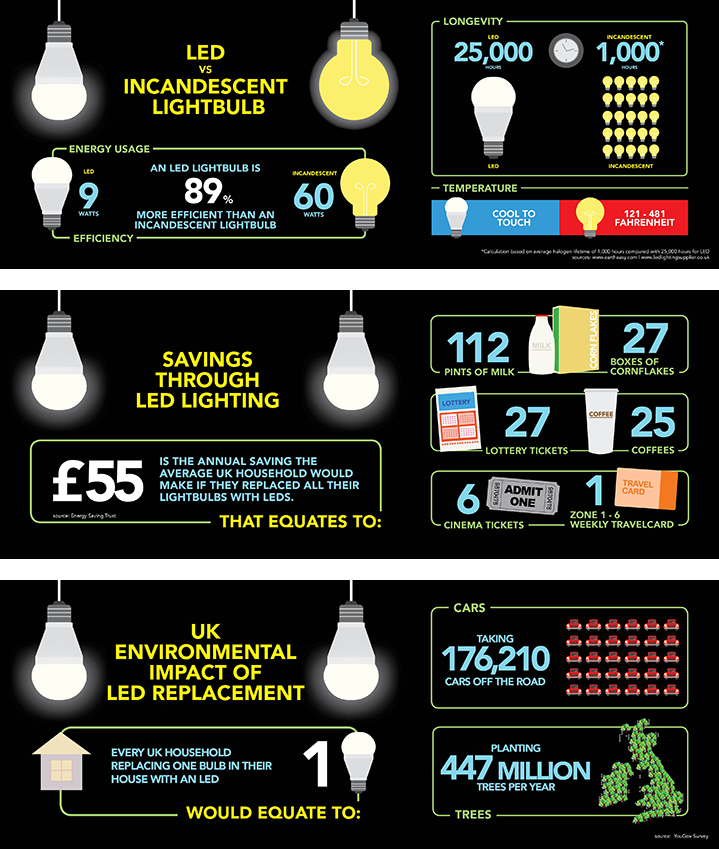Free shipping on orders over £50
TradeHURRY! SPRING SALE Now On! Get 10% Off Using Code KEEP10! Plus FREE SHIPPING On All Orders Over £50!
LED Lights Infographic From SMACK Is A Hit
 We recently discovered this rather impressive infographic on visual.ly, and thought it was good enough to share on our own blog.
We recently discovered this rather impressive infographic on visual.ly, and thought it was good enough to share on our own blog.
According to the guys who created it, SMACK, the infographic is “designed to raise awareness of the benefits of LED light bulbs over incandescent.”
Divided into three parts, the infographic illustrates the benefits of an LED light bulb in a succinct and easily digestible form.
Energy
In the first part, we see how a typical LED light bulb compares to its equivalent 60W incandescent, covering features such as energy consumption, longevity and operating temperature.
LEDs consume far less power than incandescent bulbs – up to 90% less. This is because of how much more efficient they are with their energy.
LEDs only lose about 10% of their energy to heat wastage. Incandescent bulbs on the other hand lose up to 80% of their energy to heat – this is a tenfold difference!
This explains why incandescent bulbs get so hot when they’ve been on for a while too. LEDs on the other hand remain relatively cool in comparison.
Less heat passing through the internals of the bulb itself results in the astronomical lifespan – up to 50,000 hours for most products we sell!
That’s 2 times longer than your average fluorescent, and 20 times longer than an incandescent bulb! Naturally then, LEDs win hands down.
Savings
Next up, we learn about the cost savings on a yearly basis, and what you could potentially buy with the money saved.
The amount saved will vary from person to person, depending on how many light bulbs are in your home, and how long they’re on for too. Let’s do an example of our own.
Let’s say you have an average of 30 light bulbs in your house, and you have them on for 5 hours per day. The most commonly used halogens have a power consumption of 60W, and the current UK average electricity cost is 14.05p per kWh.
If we multiply 60W by 30 units, we get 1,800W in total for all your bulbs. Multiplying this figure by 5 hours gives us 9000W per day for all your light bulbs in your house. Dividing this by 1000 gives us 9kWh per day.
Let’s now multiply 9kWh by 14.05p – this gives us 126.45p per day, or £1.26. Finally, multiplying £1.26 by 365 gives us a grand total of £461.54 – which is your total energy spend on your light bulbs alone.
Let’s go back and replace all our 60W halogens for 4W LEDs. The total kWh used per day becomes 0.6kWh, giving you a cost of 8.43p per day. Multiplying these by 365 days gives us a total of 219kWh for the year, and a total spend of £30.77.
The amount you’ll save compared to halogens is £430.77 per year!
Environment
The last part of the infographic explores the environmental impact made by every household in the UK replacing just a single light with an LED bulb. The resulting cut in carbon emissions would be equivalent to taking 176,210 cars off the road, or planting 447,000,000 trees per year.
The infographic was recently used by Panasonic on their website to promote energy saving week (22-27th October) and generated almost 100 likes on their Facebook page.
Do LEDs sound appealing now? If you’re interested in making the switch to LED lighting, our team can help you – just call 0116 321 4120, or send us an email to cs@wled.co.uk.
Keep up to date with the latest news from us, along with our products and offers, by liking us on Facebook and tweeting us @WLEDLightsUK by using the hashtag #WLEDAware.






 Search
Search


